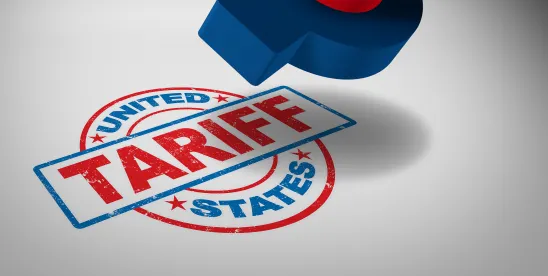President Donald Trump issued an Executive Order (“EO”) on April 2, 2025, titled Regulating Imports with a Reciprocal Tariff to Rectify Trade Practices that Contribute to Large and Persistent Annual United States Goods Trade Deficits. This EO introduces significant changes to the tariff landscape, imposing unprecedented tariff increases on most U.S. trading partners, which will have far-reaching implications for global trade and shipping. Below, we break down the key elements of the new tariff policies and their potential impacts.
Key Elements of the Executive Order
Global Tariff Implementation. The EO imposes a 10 percent global tariff on all imports into the United States, which became effective on April 5, 2025. For 57 countries identified in Annex I of the EO, an additional increase in tariffs for these countries was initially scheduled to take effect April 9, 2025, and has since been put on pause as negotiations take place, but that pause will not apply to sector tariffs. For additional information on the impact of the new tariffs announced in the April 2, 2025, EO, check out Blank Rome’s Recent Alert: Liberation Day: President Trump Unveils Global, Reciprocal Tariffs – What You Need to Know.
Product Exemptions. Annex II of the EO outlines various tariff exemptions, including certain mineral commodities, petroleum products, and pharmaceuticals. Among others, it also exempts items subject to Section 232 tariffs of the Trade Expansion Act of 1962, including automobiles and automobile parts, and steel and aluminum goods, from both the global tariff and increased reciprocal tariffs. Goods from Canada and Mexico that meet the United States-Mexico-Canada Agreement (“USMCA”) requirements are also excluded from these tariffs. However, imports that fail to qualify for duty-free treatment under USMCA remain subject to the 25 percent tariffs introduced in March 2025 (10 percent for energy and potash) under the International Emergency Economic Powers Act (“IEEPA”).
End of De Minimis Exemption and Chinese Tariffs Generally. The EO ends the de minimis exemption for goods valued at less than $800 from China and Hong Kong, effective May 2, 2025. Following administration’s latest announcement on April 9, 2025, tariffs imposed on Chinese goods surged to 145 percent. (Click here for President Trump’s April 2 amendment to the de minimis EO on China.)
Impact on Freight Rates and Shipping Strategies
Reduced Import Volume and Surge Pricing on Alternative Routes. The imposition of tariffs increases the cost of importing goods, which may lead importers to reduce or cancel shipments to avoid tariff-related costs. This reduction in demand could lead to overcapacity on specific shipping lanes, driving freight rates down.
Meanwhile, shippers may redirect cargo to tariff-free countries, increasing competition on less affected routes, which could lead to a spike in rates for these new trade lanes as carriers adjust to shifts in global trade flows. The net effect will be a rerouting of the world’s trade lanes to some currently unknown extent.
Also, as new tariffs take effect, some importers may be unwilling or unable to pay the new duties, leading to delays in cargo pickup or increased cargo abandonment, especially in container terminals. In the short run, these issues could give rise to additional congestion and delays in container ports, before volumes begin to decline.
Sector-Specific Pricing. Freight rates for diverse types of vessels, e.g., bulk carriers, container ships, and RoRo vessels, likely will experience varying impacts depending on the industries targeted by tariffs. For example, tariffs on high-value manufactured goods can reduce containerized cargo demand, affecting major shipping routes including the trans-Pacific, trans-Atlantic, and Asia-Europe corridors.
Real-World Strategies for Ship Owners
Diversification and Fleet Management. Shifting operations to tariff-free trade routes can help offset losses from lower rates on affected routes. For instance, previous U.S. tariffs on Chinese goods led businesses to relocate manufacturing to other Southeast Asian countries, including Vietnam, Thailand, and Malaysia, and more such shifts are expected. Maintaining ongoing discussions with key shippers and charterers, adjusting fleet deployments, and conducting fleet repositioning and sailing frequency assessments to align with high-demand routes can optimize utilization and profitability.
Outlook
It is unclear whether the tariffs represent a “new normal” for U.S. trade or whether bilateral agreements will be reached to provide significant tariff relief for impacted countries. The uncertainty makes it difficult for carriers, ports, and shippers to make investment decisions regarding redeployment of vessels and equipment and making capital investments in terminals and logistics infrastructure.
In the United States Congress, bipartisan legislation has been proposed in the Senate regarding the president’s ability to impose tariffs, an authority specifically vested in Congress by the Constitution. However, congressional leaders have indicated that the legislation is unlikely to progress at this time.
In addition, private litigants, including the New Civil Liberties Alliance, have brought lawsuits challenging the president’s unprecedented use of emergency declarations under IEEPA to impose tariffs and reshape foreign trade. In its nearly 50-year history, no other president has ever sought to use IEEPA, the statute that underpins most U.S. trade sanctions programs, as an authorization to impose tariffs on an emergency basis.
Conclusion
A state of flux bests describes today’s global marketplace. Should these tariffs remain in place, trade lanes will evolve and manufacturing likely will shift to lower net production cost locations. The trade landscape demands vigilance, communication, cooperation, and adaptability from shippers and ship owners. Monitoring trade policy shifts, investing in emerging markets, and optimizing fleet deployment strategies are crucial steps to navigate the challenges posed by new tariff policies. By staying informed and proactive, stakeholders can position themselves to seize opportunities and mitigate risks in this dynamic global environment.





 />i
/>i
